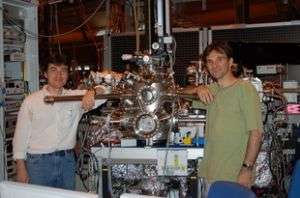Researchers Study Superconductivity, Magnetism in Novel Material

A University of Arkansas physics professor and his colleagues have created a nanoscale structure that contains both magnetic and superconducting properties at the same time, and they will be exploring the properties of this novel material this summer in Switzerland.
Jacques Chakhalian and his colleagues at the Max Planck Institute in Germany and the University of Grenoble and the National Center for Scientific Research, both in France, have been awarded research time and financial support over the next two years at Swiss Light Source at the Paul Scherrer Institut – the most advanced synchrotron light source in the world. In 2006, they published a paper in Nature Physics documenting novel properties at the interface between a superconductor, known as YBCO, and a ferromagnet, known as LCMO. Their results showed an interplay between ferromagnetism and superconductivity that had never been documented before.
“Typically, ferromagnetism destroys superconductivity,” Chakhalian said. The group’s technique, which allows scientists to combine these two properties in one thin-film superlattice, opens up a new area of physics and paves the way for discovering more materials with novel properties.
To create the lattice, the researchers take a powdered pallet of the material and use a powerful ultraviolet laser to vaporize the crystals and deposit them as a multilayer, ultra-thin film on a substrate. This way they can create one atomic layer at a time.
“You can make it as thin as you want,” Chakhalian said. To find out more about the unique properties of the superconductor/ferromagnet material, the research group wants to look at the interface between the two materials. They plan to do this using the synchrotron at Swiss Light Source.
The synchrotron light is electromagnetic radiation of varying wavelengths that can be tuned to a specific wavelength for a particular experiment. The spectrum at Swiss Light Source varies from infrared light to soft and hard X-rays. Unlike conventional X-rays, which diffuse through space, the synchrotron light beams are sharply focused like a laser beam. This will allow Chakhalian and his colleagues to study the magnetic and superconducting properties at the interface of this nanoscale material.
“The main technical challenge is to focus the beam of low energy photons into a spot the size of a few hundred microns,” Chakhalian said. Only a few facilities in the world, like Swiss Light Source, have the technology to create the “soft” X-rays necessary to analyze the electronic properties of the superconductors and ferromagnets.
The team will conduct their experiment at Swiss Light Source starting June 18. They will have seven days to complete the first phase of the research. The award will allow them to return to use the synchrotron again more than once over the next two years. In the meantime, they will be busy working with the results of their first experiments. This project provides a perfect training ground for University of Arkansas graduate students who are interested in nanoscience and nanotechnology
“It takes a lot of intellectual effort to analyze the data,” Chakhalian said.
Chakhalian is an assistant professor of physics in the J. William Fulbright College of Arts and Sciences. In addition to working at the Swiss Light Source, he also works at the Advanced Photon Source, Argonne National Laboratories and the ANKA Synchrotron Light Source in Germany.
Source: University of Arkansas, Fayetteville





















